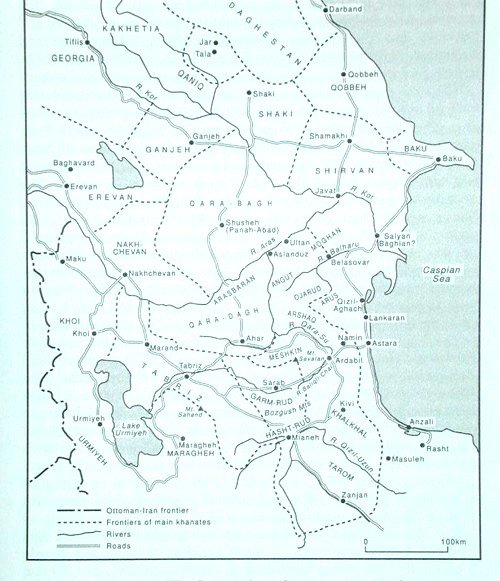
The Salon du Tapis d'Orient is a moderated discussion group in the manner of the 19th century salon devoted to oriental rugs and textiles and all aspects of their appreciation. Please include your full name and e-mail address in your posting.
The Confusion about Shahsevan
by Bertram Frauenknecht
Thirty years ago nobody
knew the Shahsevan. Now you find the term used for all kinds of rugs,
even on eBay. Who or what were or are they?
There is still a small
group of nomads in southern Azerbaijan who were the subject of fieldwork
by Richard Tapper in the 1960's. Later they enjoyed a number of visitors,
usually rug people with different theories, describing these nomads, especially
their rugs and textiles, and predominantly their soumacs. Tanavoli's
book, Shahsavan, showed us a lot of different designs and the
regions where they were made. This is what we know as of today.
Most probably they originated
in the call for support by Shah Abbas in the early 17th c., although there
is no direct proof of this. In 1637, the traveller Olearius wrote, "...sheep-herds
and cow-herds who marched with their houses..." about nomads in the
Moghan steppe, which has always been an area of interest for all kinds
of powers. He mentions names of tribes - they are the same as those
of the present day.
In 1647, troops stationed
in Baku bore the name Shahsevan. In 1648 the garrison in Derband
was composed of Afshar and Shamlu Shahsevan. In 1707, Cornelis de
Bruin remarks on his travel through the Moghan that there are large numbers
of Tatar nomads and their animals. This term is important, as
it can be regarded as fact that most nomads in the Moghan were Shahsevan
by this time. De Bruin also mentions an irrigation project by the
Khan-governor who lived in Moghan in summer and in Ardebil in winter. This
Khan must have been Abbas Qoli Khan Shahsevan, governor of Moghan and Lenkoran.
A document dated 1709
shows pasture dues of Karabagh and Gendje received by Shahsevan chiefs. In
1717, the Russian Volynskiy wrote about the inhabitants of the Moghan traveling
as nomads between Kor and Aras. This would now be Karabagh.
The next events, the Afghan
wars, changed the picture completely. The Safavid eventually
disappeared and were followed by Tahmasp-qoli Khan who mounted the throne
as Nadir Shah in the area of Javat in the Moghan. John Cook, who
passed there 11 years later (1747), was told that "upwards of a hundred
thousand tents" were encamped there during this event.
Under Nadir Shah, the Shahsevan were displaced to the areas between Zanjan
and Qazwin, partly to Khorrasan. That is when they started to establish
themselves in Ardebil, as Badr Khan (Afshar Shahsevan) was appointed chief
of the Shahsevan tribes of Moghan and Ardebil. Possibly the Moghani were
not nomads at all, but farmers settled in the irrigated lands who took to pastoral
nomadism only in the troubled times of the 1720's and later had no choice as
Nadir destroyed the canals.
For the next 50 years,
the Shahsevan chiefs ruled as Khans in the Ardebil district and in Javat,
where they covered roughly the major northeastern part of the steppe. It
is interesting that the Meshkin Shahsevan were the only group of tribes
without an urban center. It is in this period that the Shahsevan
were the most important tribal group in Persia, covering an area from Derbend
to Qazwin, from Lenkoran to Nakhchevan,

This map shows the area
controlled by the Shahsevan in the mid-18th century. Ganjeh is Kirovabad;
Qobbeh is Kuba. The next map is contemporary, showing approximately
the same area.
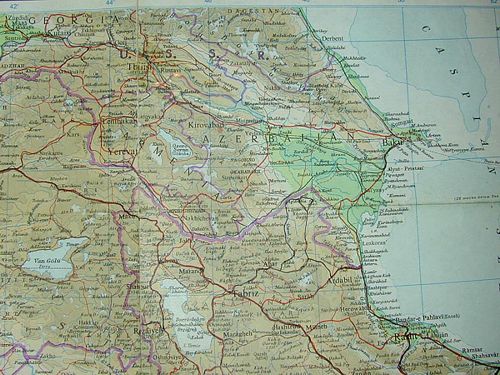
During the 18th century,
which can be considered the most prosperous period of the "tribe", they
were expanding, gaining power, and losing it again through jealousy and
resentment. The origin was under the Safavid Shahs, where a declaration
of shahi sevani by a tribal chieftain implied that he regarded
it as a religious and moral duty to follow his sovereign. By the
mid-18th century they had lost this moral attachment and the Khans were
fighting each other under constantly changing alliances.
The Russians who had tried
to take Azerbaijan as early as 1722 and were driven out, started their
pressure in the late 18th c. and after the battle of Aslanduz (southwestern
Moghan) in 1812 the Shahsevan had the choice between becoming Russian citizens
or retreating south. Tapper says that groups with Shahsevan names
nomadized in Shirvan and elsewhere north of Moghan, and that there was
indeed considerable movement in a northerly direction in that time. In
1828 the border was drawn along the Aras river cutting off the nomads from
Moghan, more than two-thirds of their winter quarters. From that
time on, the term Shahsevan has been used
almost exclusively for the nomads who fought against the Russians, the
Meshkin group. All the Shahsevan who stayed in Russia and became half settled
abandoned the old name, as they were no longer ruled by a Shah. The
Shahsevan in the area between Zandjan-Qazwin-Saveh lived as farmers and
gave up nomadism.
Richard Tapper, together
with a number of early travelers, provide a colorful picture of Shahsevan
history up to that point. Being interested in their weavings, we
need to look further and find information gathered towards the end of the
nineteenth century by a group of European scientists who were in Tiflis
as teachers at the gymnasium (high school, founded 1802) or as director
of the Caucasian museum. Here we find the term Tatars again,
describing them as former inhabitants of the Moghan, Shi'ites, speaking
a Turk-Persian dialect, wearing red-brown hats made of sheepskin (Kizil-bash). They
numbered 1,140,000 in 1896.
The description of their
tents points directly to the Shahsevan tent. They are described as
producers of many rugs ...during the long winterevenings the women
spin and weave... The teacher, C. Hahn, writes that many of
them are wealthy, live in nice houses and many are amongst his pupils. There
is overwhelming evidence that many rugs were made in the Transcaucasus
by ex-Shahsevans. There were 21,000 Tatars in Zakatala, as well
as in many other areas including Talish, Shirvan, Gendje, Karabagh and
especially the Moghan up to Baku.
Among the Shahsevan groups
in the Zandjan - Qazwin area we find designs on soumacs closely related
to those from Moghan and elsewhere. We also can say that the soumac
bag is quite unique for the Shahsevan. I dare say that it may
have been an invention of these people during the 18th century, as a way
of having something valuable to trade or sell. This must have happened
prior to the time of displacing by Nadir, as the designs seem to have had
an independent development.
Accordingly, many carpets were produced
carrying similar or closely related designs. Especially amongst Caucasian
rugs we find many which carry clear Shahsevan symbols. Carpets were needed
to sit on, to sleep on or under, as protection against cold. They
are mentioned as being in many houses and auls. Influences from neighbouring
people surely have changed designs, as we can see that the southern Shahsevan
produce rugs with different designs than those of the northern Shahsevan. Take
the Afshar Bidjar as an example. It is probably a Kurdish rug originally,
but the Afshar Shahsevan who were neighbours there took the design over
and produced the better quality. To stretch my point, we can talk
of a Shahsevan Gendje or a Shahsevan Shirvan. What is now awaiting
our understanding is that the term Shahsevan is comparable to
the term Turkmen, and we can start by accepting that a Moghan
rug is a Shahsevan rug.
We can even go further,
as we know that the original call by Shah Abbas brought many Turkish families
of Turkmen origin to Azerbaijan. (This is the legend of origin of the Shahsevan,
reported by Tapper and others). Many Caucasian rugs show Turkmen designs.
Those can very well be Shahsevan as there were only few Turkmen living
in the area. In 1897 they were counted as 8900 individuals. I have a comparison
here of a very old Turkish Yastik fragment and a well known type of Shahsevan
weaving

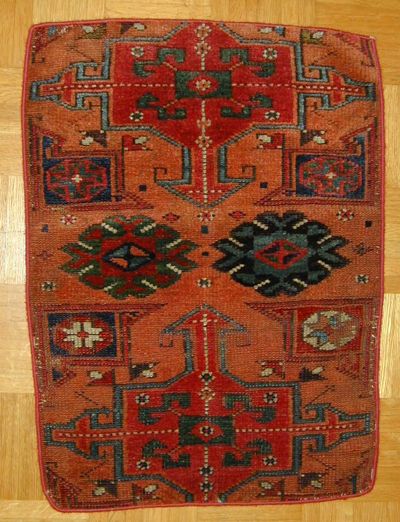
Here are three examples
of rugs that I believe can properly be called Shahsevan.
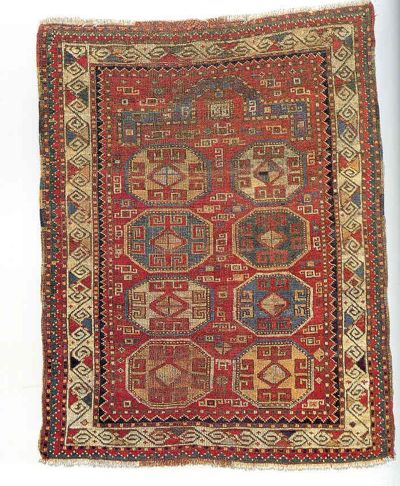

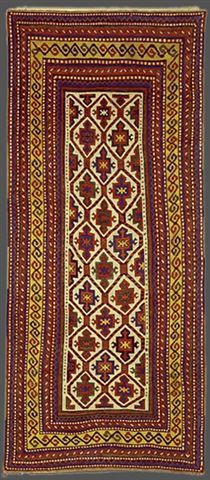
Further studies should
enable us to point out Shahsevan symbols in ‘Caucasian’ rugs and also comparison
of structure will help. Eventually we would have a Zakkatala Shahsevan
with a borrowed Lesghi star, dark brown wefts but bright Shahsevan colors.
Or we could decide for a soumac bag made by Karabagh Kurds – the Shaqaqi
tribe – part of the Shahsevan confederacy in the 18th century.